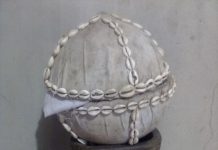Click here for previous session
In recent years, many have found their doubts strengthened by a trail of engaging
theories in books of critical Christian challenge. One such work, The Jesus Conspiracy
by Holger Kersten and Elmar R. Gruber, is of particular interest with regard to the subject
of this chapter, for the authors present powerful evidence that whoever was wrapped in
the Shroud of Turin did not die. Kersten and Gruber proposed that the Catholic Church
realized the devastating impact this theory, if true, could have. After all, if the evidence
suggested that Jesus had been wrapped in the shroud but did not die, the church would be
left without a death, without an atoning sacrifice, without a resurrection and, in short, the
church would be left without a church. In the words of First Corinthians 14:1415, “And
if Christ is not risen, then our preaching is empty and your faith is also empty. Yes, and
we are found false witnesses of God….”
The authors claim the church responded by deliberately discrediting the shroud,
even to the extent of falsifying carbon dating tests. Well … maybe. The authors’ evidence is substantial, and … their logic is
compelling, and … they may be wrong. Then again, they may be right. Chances are,
we’ll never know. About the only thing we do know about the shroud is that the Catholic
church has not taken a position on the authenticity of the shroud, and we have to wonder
why it objects to more independent testing. If unauthentic, the shroud is little more than
an oddity, so why not trim some insignificant snippets off the edges and pass them around? But no, the custodians keep the shroud under lock and key, and we have to
wonder why, if not because they fear the results.
In any case, Muslims believe that Jesus was never crucified in the first place, “but
so it was made to appear …” (TMQ 4:157). If the proposal sounds outlandish to those
who have been raised to think the opposite, the doctrine of the crucifixion sounds
stranger still when placed beside Deuteronomy 22:23, which states, “He who is hanged
[i.e., either on a gallows or crucified] is accursed of God.” Simultaneous claims to
biblical inerrancy and to the divine sonship of the crucified Jesus cast a truly peculiar
light on anyone who supports such beliefs, for the contradiction is obvious. Either Jesus
was not crucified, the Bible is in error, or, according to the scripture, Jesus was accursed
of God. To hold that God’s prophet, son, or partner (however a person regards Jesus) is
also accursed of God can only achieve acceptance among those with synaptic sterility.
The above pieces simply do not fit the package. Something has to give—one or more of
the nonconforming elements need to be recognized for what it is—a sham—and cast out.
Otherwise, the package as a whole bears the impossible qualities of makebelieve, or
perhaps we should say, “makebelief.”
Similarly confounding is Hebrews 5:7, which states that because Jesus was a
righteous man, God answered his prayer to be saved from death: “In the days of his flesh,
Jesus offered up prayers and supplications, with loud cries and tears, to the one who was
able to save him from death, and he was heard because of his reverent submission”
(Hebrews 5:7, NRSV). Now, what does “God heard his prayer” mean—that God heard it
loud and clear and ignored it? No, it means God answered his prayer. It certainly can’t
mean that God heard and refused the prayer, for then the phrase “because of his reverent submission” would be nonsensical, along the lines of, “God heard his prayer and refused
it because he was a righteous man.”
Now, while Muslims deny the crucifixion of Jesus, they don’t deny that someone
was crucified. So who do Muslims think was crucified in his place? It’s a moot point, and
not terribly important. Some suggest that Allah raised Jesus up and altered Judas’ features
to resemble those of Jesus, with the end result that Judas was crucified in his place, to the
deception of the audience. Well, maybe. But then again, maybe not. There’s no
compelling evidence to support this opinion, even though it does conform to the biblical
and Qur’anic principles of people reaping what they sow.
Notably, there are those who object to the suggestion of Judas being crucified on
the basis that, as per Matthew 27:5, Judas threw his illgotten silver back at the priests
and “went and hanged himself.” So he wasn’t around to be crucified. On the other hand,
Acts records that Judas “purchased a field with the wages of iniquity; and falling
headlong, he burst open in the middle and all his entrails gushed out” (Acts 1:18). So if
the authors of Acts and Matthew don’t agree on the matter, what really happened is
anybody’s guess.
Perhaps we can look at this issue from a different angle. If the idea of Judas being
crucified in Jesus’ place sounds technically strained, maybe it shouldn’t; God is described
as having restrained the eyes of two disciples (i.e., intimate companions who should have
readily recognized their teacher) when they met the allegedly “risen” Jesus on the road to
Emmaus, “so that they did not know him” (Luke 24:16). Another biblical example would
be that Mary Magdalene reportedly failed to recognize Jesus outside of the tomb, “supposing him to be the gardener …” (John 20:15). Mary Magdalene? Shouldn’t she
have been able to identify him, even in the early morning light?
Interestingly enough, this concept of a crucifixion switch isn’t entirely foreign to
Christianity. Among early Christians, the Corinthians, the Basilidians, the Paulicians, the
Cathari and the Carpocratians all believed Jesus Christ’s life was spared. The Basilidians
believed that Simon of Cyrene was crucified in his place, which may not be an
unreasonable suggestion, considering that Simon carried Jesus’ cross (see Matthew
27:32, Mark 15:21 and Luke 23:26). Typically, all of the dissenting sects mentioned
above were judged to have been Gnostics and/or heretics by the church, and were
violently suppressed by a Trinitarian majority that systematically burned dissenters into
oblivion for the first fifteen centuries of Catholic rule (the most recent roasting having
taken place in Mexico in 1850 CE).






